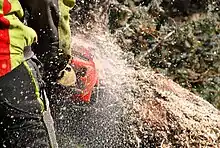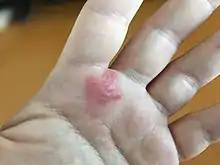Health impacts of sawdust
Any type of woodworking that involves cutting, either by hand or machine, releases sawdust. Because sawdust within 2-10 microns can float through the air, it can be easily inhaled without proper protection, leading to damaging injuries to a woodworker's skin and lungs.

Exposure
Exposure to sawdust most commonly comes from working with wood, whether it be sanding, sawing, or routing. Uncommonly, sawdust exposure can come from sweeping dust off of old furniture, which may haw sawdust particles inside.[1]
Risks
Respiratory
Human lungs have the capability to filter out big chunks of sawdust. However, the main risk are the fine particles that can easily float in the air and bypass a lung's natural filter. These small particles clog up air passageways within the lungs. Symptoms such as sneezing, watery eyes and breathing problems are the first signs of damaging sawdust exposure. Long term affects of sawdust exposure can lead to asthma and in worse cases, lung cancer.[2]

Skin
Contact dermatitis can be caused from long exposure of sawdust with direct contact with skin. Itchiness is the leading symptom, followed with rashes, blisters, and scaling.[3]
Wood Types
Woods such as plywood or fiberwood produce above average amounts of sawdust due to being primarily made of wood chips or particles, and are especially dangerous. When cut, these chips and particles are released into the air, only smaller.
Some woodworkers may have allergic reactions to certain woods, which can amplify the symptoms above if not treated.
Prevention
Clothing and Gear
.png.webp)
One of the easiest ways to prevent sawdust exposure is by wearing the safest gear for woodworking.
Woodworking Equipment

- A vacuum is another simple way to prevent sawdust exposure. Any sawdust remaining on the ground is prone to being kicked up and inhaled. Vacumming regularly after each cut will minimize any exposure
- A dust bag or collector can be attached to most woodworking machinery, collecting any sawdust automatically.
See also
References
- Government of Canada, Canadian Centre for Occupational Health and Safety (2023-06-13). "CCOHS: Wood Dust - Health Effects". www.ccohs.ca. Retrieved 2023-10-20.
- Zealand, WorkSafe New (2022-12-19). "Wood dust: controlling the risks". WorkSafe. Retrieved 2023-10-20.
- Smith, Chris (2017-04-12). "The Hidden Health Dangers of Sawdust". Monarch Metal. Retrieved 2023-10-20.